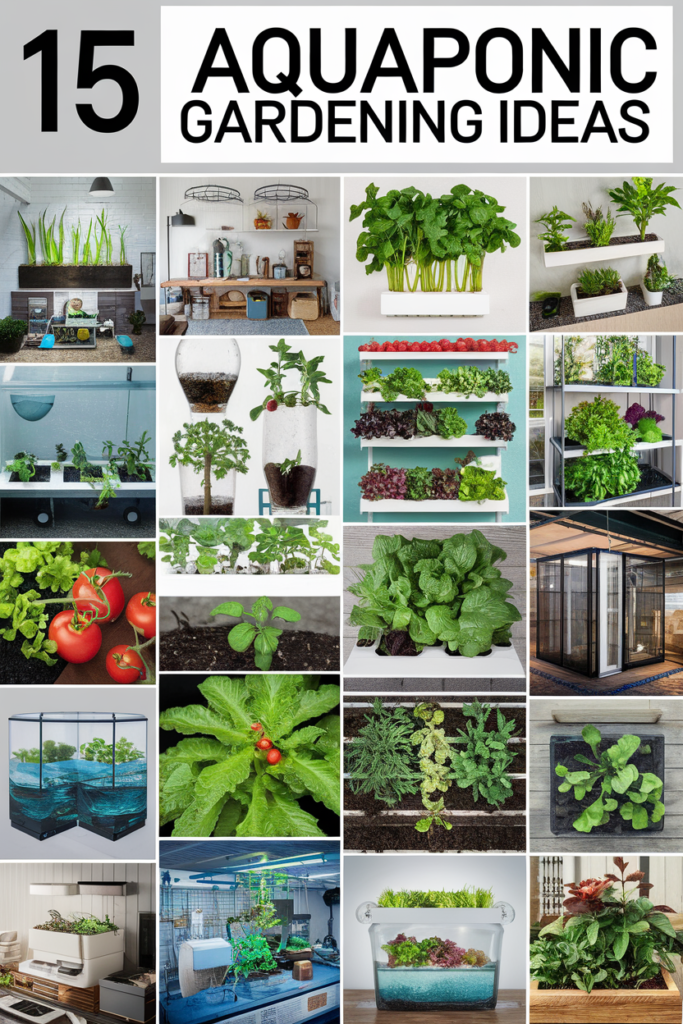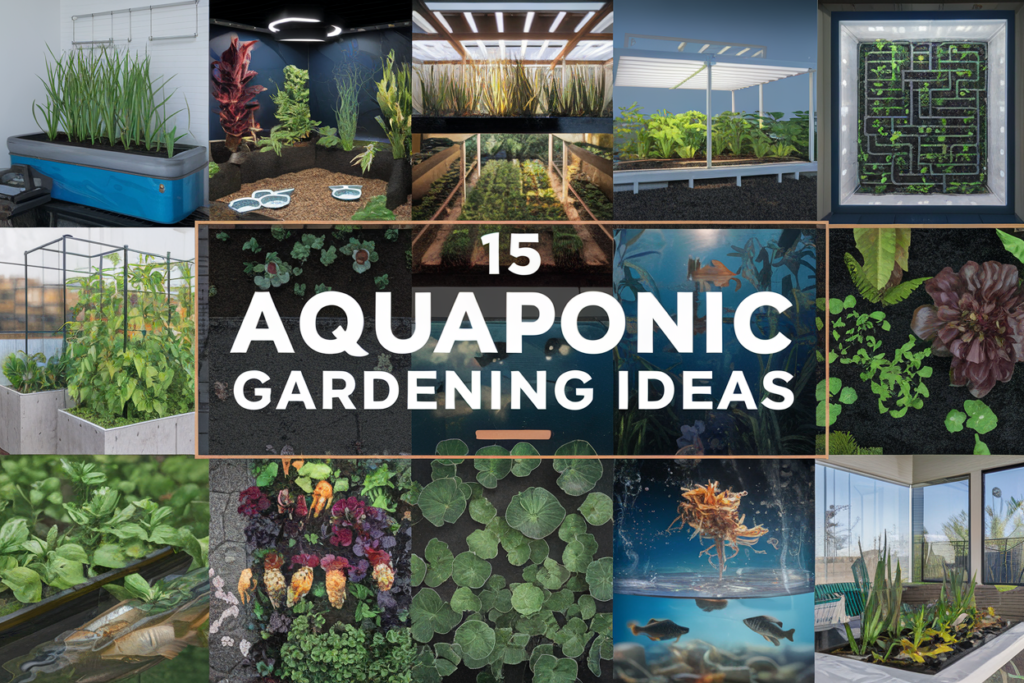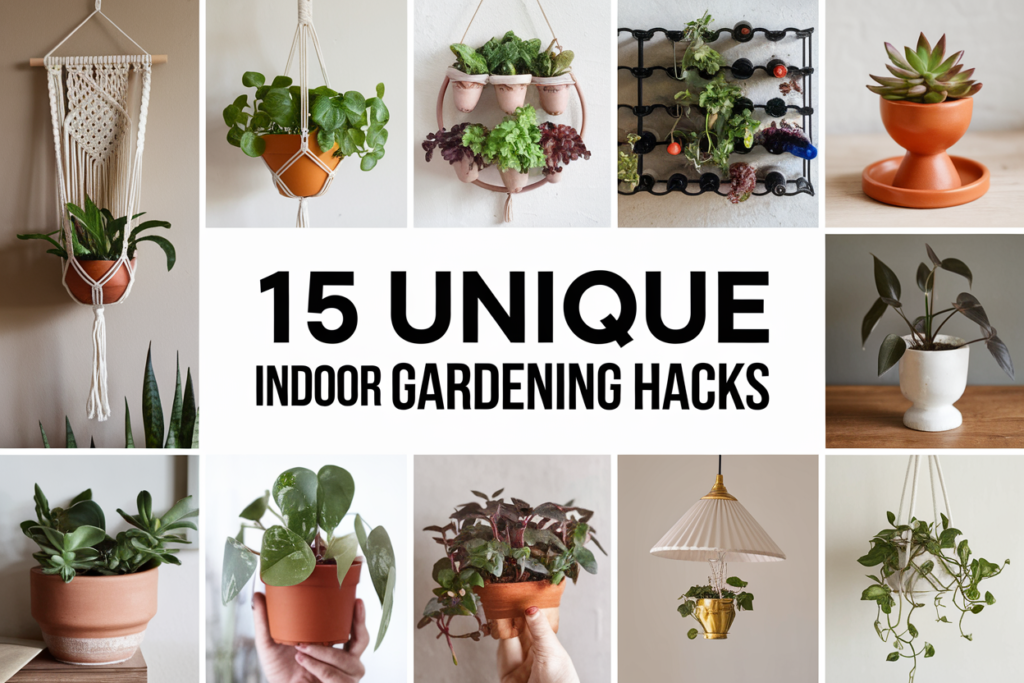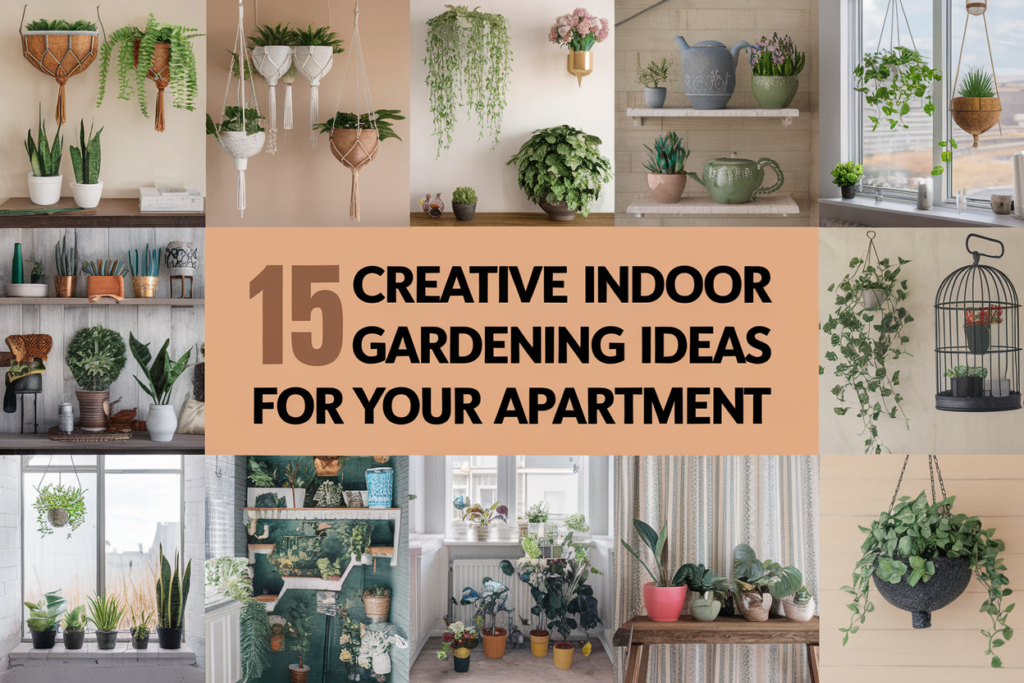Ready to spice up your gardening game? Here are 15 creative aquaponic gardening ideas that will not only make your backyard pop but also help you grow your own food sustainably. From vertical gardens to DIY fish tanks, there’s something here for everyone, whether you’re a seasoned pro or just getting started!
Start With A Simple Fish Tank And A Few Plants To Test Your System.

Using a basic fish tank is a great way to kick off your aquaponic journey. In the image, you can see a small, vibrant tank featuring a goldfish swimming around colorful plants. This setup is perfect for beginners. It allows you to observe how fish and plants can thrive together.
Start with a few easy-to-care-for plants like lettuce or herbs. They grow well in water and adapt easily to the system. The fish provide nutrients through their waste, and the plants help clean the water. This balance is what makes aquaponics so exciting.
Keep an eye on your fish and plants. Watch how they interact and grow. This simple setup can help you learn the basics before diving into larger projects. Plus, it’s a fun way to enjoy gardening indoors!
Grow Leafy Greens Like Lettuce And Spinach, Which Thrive In Aquaponics.
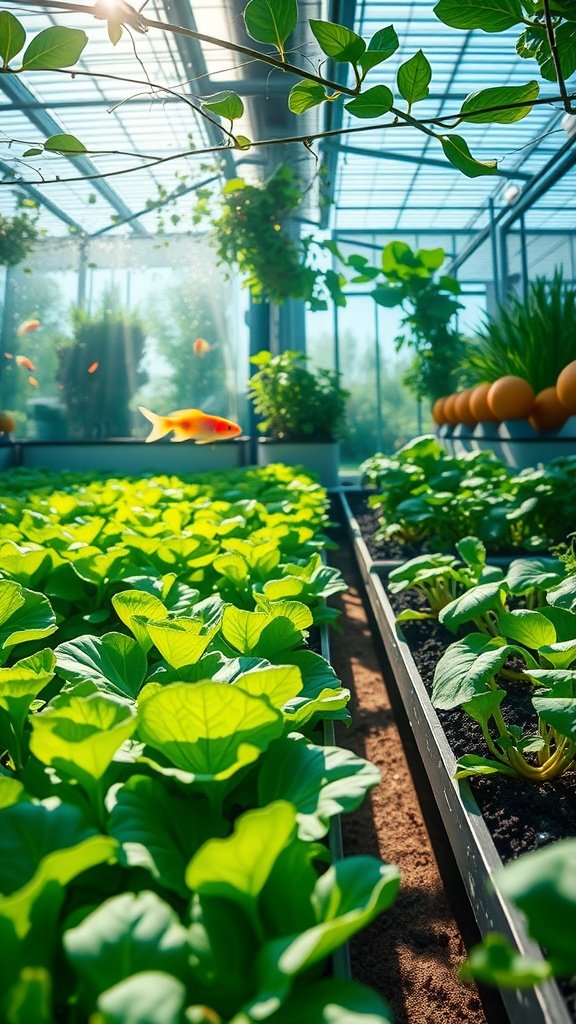
The image captures a vibrant aquaponic garden filled with lush leafy greens like lettuce and spinach. Bright green leaves stretch upwards, soaking in the sunlight that streams through the glass greenhouse. The combination of plants and fish creates a harmonious ecosystem, where fish provide nutrients for the plants while the plants help filter the water for the fish.
This setup is perfect for growing healthy greens. Leafy vegetables love the nutrient-rich water that comes from the fish tank. Both lettuce and spinach grow quickly in this environment, making them ideal choices for beginners. They don’t require much space, so you can easily fit them into any aquaponic system.
Aside from being easy to grow, these greens are nutritious and versatile. You can use them in salads, sandwiches, or smoothies. They are also packed with vitamins and minerals, making them a great addition to any diet. Plus, growing your own means you can enjoy fresh greens right from your home.
Use A Floating Raft System For Large-Scale Plant Growth.
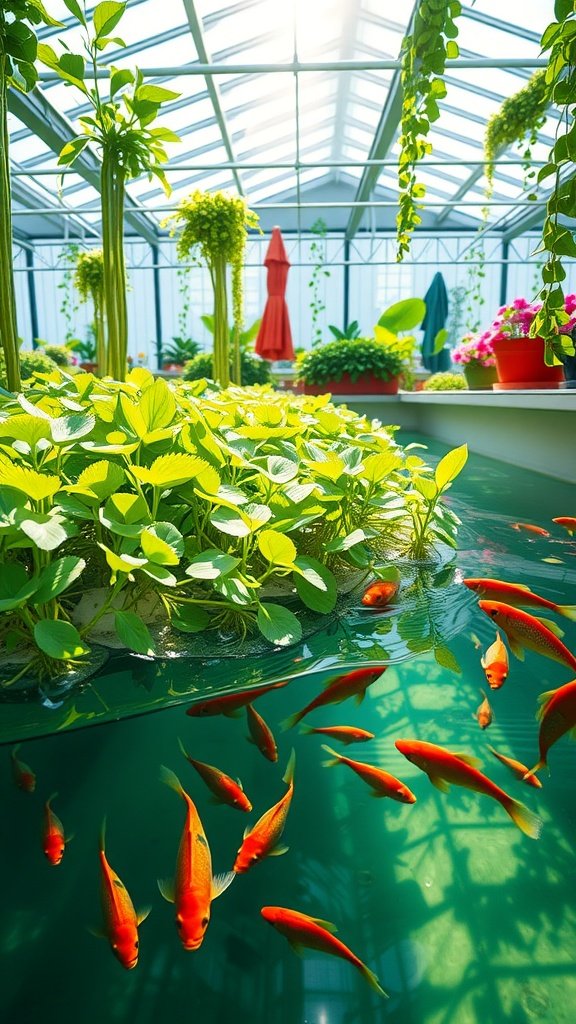
A floating raft system is a cool way to boost your aquaponic garden’s efficiency. In this system, plants grow on a raft that floats on water. The roots dangle into the water, where they can soak up nutrients and oxygen. This method works great for big plant growth, especially if you’re looking to increase your yield.
In the image, you can see vibrant green plants thriving on a floating raft, with fish swimming below. The setup allows plants to access nutrients directly from the water. The sunlight streaming in creates a bright and inviting atmosphere, making it ideal for growing a variety of plants.
Using a floating raft system not only maximizes space but also ensures that your plants receive all they need to flourish. This method is perfect for larger-scale setups, like community gardens or educational projects. Plus, who doesn’t love watching fish swim around while tending to their plants?
Integrate Edible Fish Like Tilapia To Boost Nutrient Cycles.
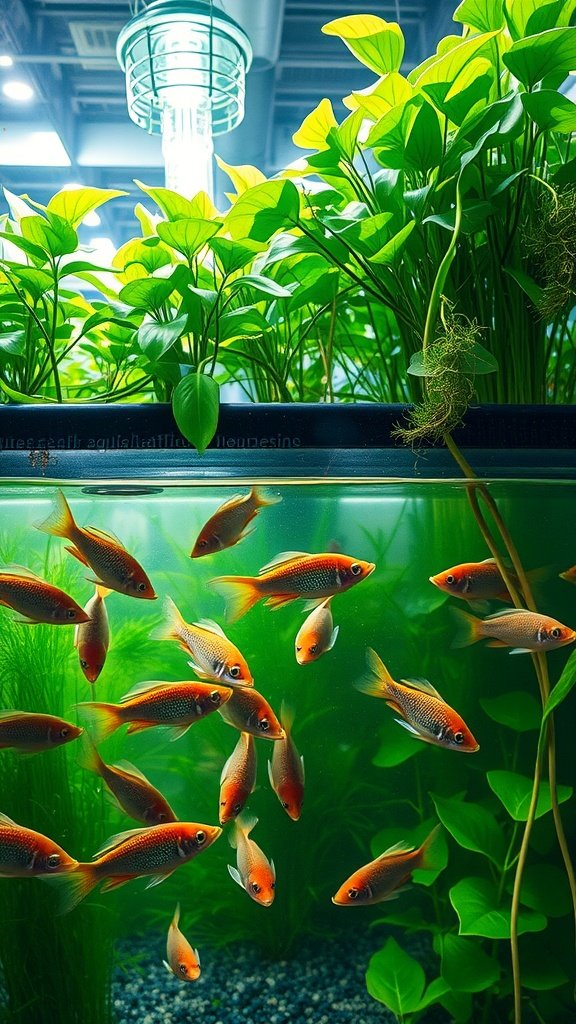
In an aquaponic system, integrating edible fish like tilapia can greatly enhance the nutrient cycle. The image above shows a vibrant underwater scene filled with tilapia swimming among lush green plants, creating a balanced ecosystem.
Tilapia are a perfect choice for aquaponics. They are hardy, grow quickly, and thrive in various conditions. As they feed, they produce waste that is rich in nutrients. This waste then breaks down and becomes food for the plants growing above.
The plants, in turn, filter the water, keeping it clean for the fish. This symbiotic relationship ensures a sustainable environment. It’s fascinating how both plants and fish depend on each other to flourish.
Setting up this type of system is an exciting project. You get fresh fish and vegetables right from your backyard. Plus, watching the fish swim while the plants grow creates a lovely, calming atmosphere.
Combine Aquaponics With Vertical Gardening To Save Space.
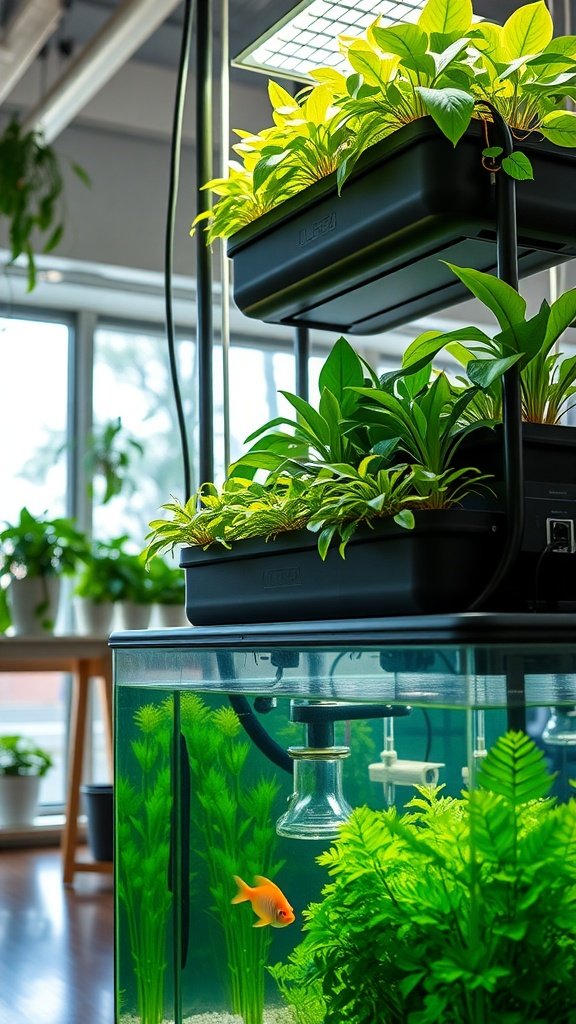
Picture a vibrant setup where lush green plants thrive above a sparkling aquarium. This image perfectly captures the beauty of combining aquaponics with vertical gardening. The top layer features various leafy plants, while below, a small goldfish swims gracefully through clear water, creating a lively ecosystem.
This method not only saves space but also maximizes the use of resources. Plants grow in nutrient-rich water from the fish tank, while the plants help filter and clean the water for the fish. It’s a beautiful cycle that benefits both plants and aquatic life.
Vertical gardening allows for a greater variety of plants in minimal space. You can grow herbs, vegetables, or even decorative plants. The light above ensures that all the greenery receives ample sunlight, promoting healthy growth.
This setup is perfect for small apartments or urban homes where space is limited. It brings nature indoors while providing fresh produce and a unique aesthetic. So why not consider this creative approach for your own green space?
Create An Indoor Aquaponic Garden For Year-Round Fresh Produce.
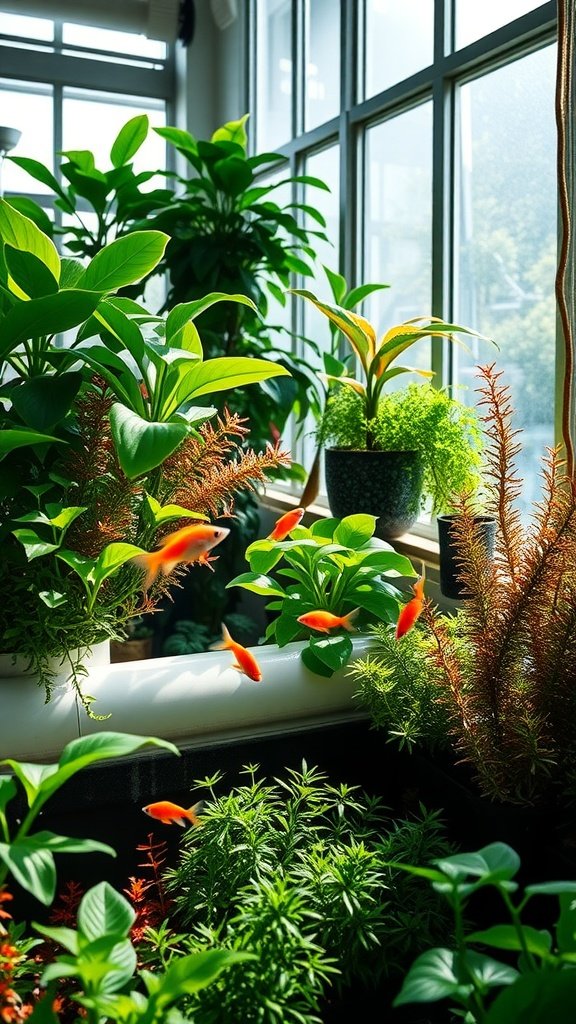
Imagine a vibrant space filled with lush greenery and bright fish swimming gracefully. An indoor aquaponic garden can turn this vision into reality. The image showcases a sunny room where plants thrive under natural light, creating a lively atmosphere.
It’s a perfect blend of plants and fish, working in harmony to grow your favorite herbs and vegetables. The fish provide nutrients for the plants, while the plants purify the water for the fish. This sustainable cycle means you can enjoy fresh produce all year long!
Setting up your own indoor aquaponic garden is simpler than you might think. Start with a small fish tank filled with fish like goldfish or tilapia, and place a variety of plants in floating containers above the water. This setup allows you to monitor growth and enjoy the beauty of both plants and fish.
With some care and attention, your indoor garden can flourish. Water and light management is key. Ensure your plants receive enough sunlight, and check the water quality regularly. Soon, you’ll be harvesting your own fresh greens, right at home!
Build A Diy Media Bed Using Gravel Or Clay Pebbles.

Creating a DIY media bed is a fantastic way to enhance your aquaponic gardening setup. The image showcases a well-structured media bed filled with gravel and clay pebbles, perfect for supporting plant roots while facilitating excellent drainage.
Using gravel or clay pebbles offers numerous benefits. These materials provide a stable growing environment, allowing plants to thrive. The pebbles create spaces for beneficial bacteria to grow, which plays a key role in converting fish waste into nutrients for your plants.
To set up your media bed, start by choosing a suitable container. Fill it with a mix of gravel and clay pebbles, ensuring enough depth for root growth. Finally, plant your favorite herbs or vegetables, and watch them flourish in this supportive environment!
Use Rainwater For Your Aquaponic Setup To Conserve Resources.
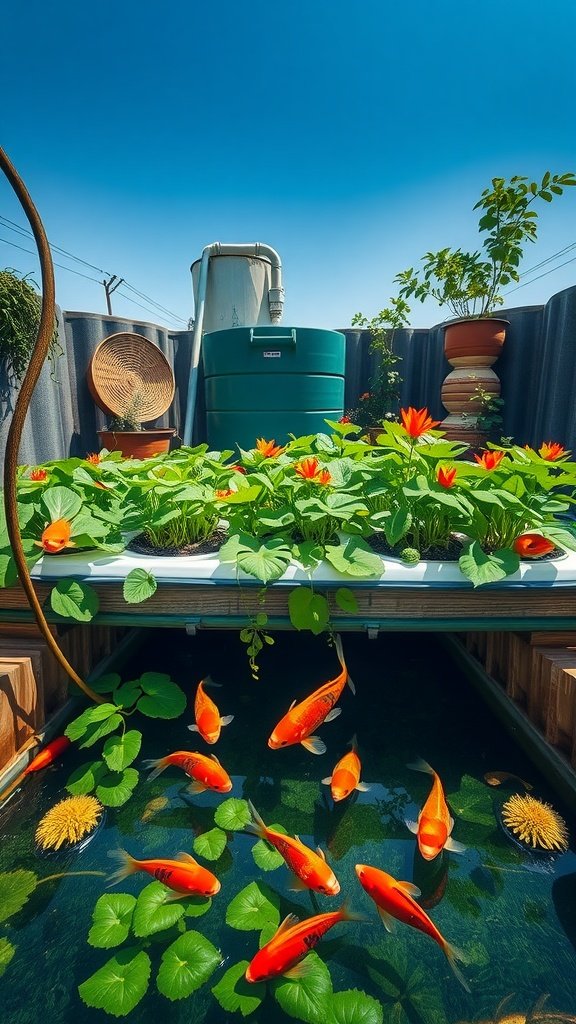
Using rainwater in your aquaponic system is a smart way to save resources. The image shows a vibrant setup with a tank for collecting rainwater, fish swimming underneath leafy greens, and beautiful flowers brightening the space. This kind of setup not only looks appealing but also makes efficient use of natural resources.
Rainwater can provide essential nutrients for plants while keeping your fish healthy. It’s a sustainable choice that reduces the need for municipal water, making your garden eco-friendly. With a rainwater collection system, you can capture and store this precious resource to use during dry spells.
By integrating rainwater into your aquaponics, you create a more self-sufficient garden. It’s an easy way to support your plants and fish while helping the environment. Consider setting up gutters and barrels to collect rainwater from your roof. This small change can have a big impact on your gardening efforts.
Install A Bell Siphon To Manage Water Flow And Oxygenation.
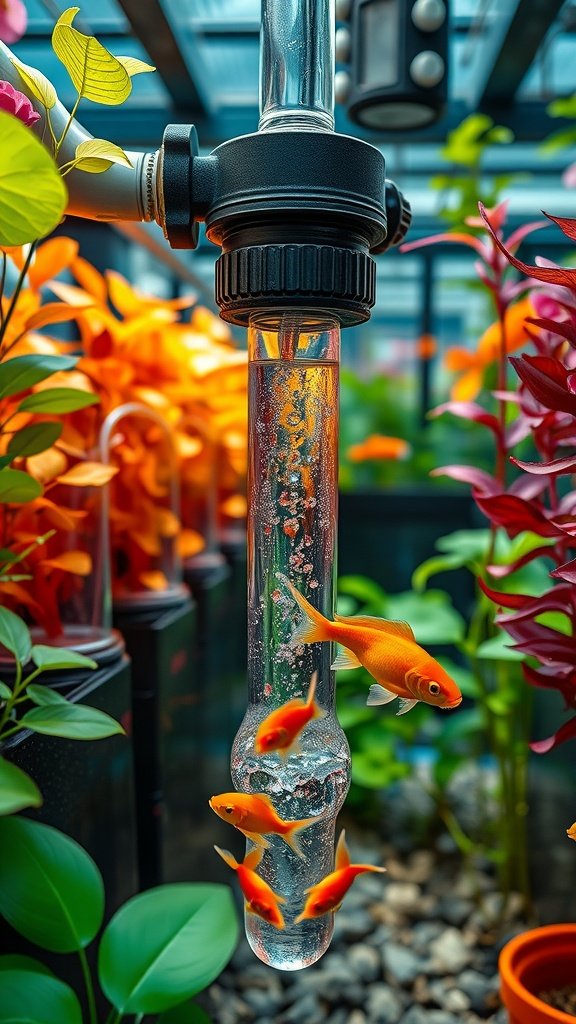
A bell siphon is a nifty device to help manage water flow in your aquaponic system. The image shows a clear view of a bell siphon in action, with bubbles rising through the tube and fish swimming nearby. This setup allows for efficient water cycling, crucial for both plants and fish.
The bell siphon works by creating a vacuum that pulls water from one area to another, ensuring that your plants get the nutrients they need. It’s like a natural pump that helps oxygenate the water too, benefiting your fish.
If you want to set this up, you’ll need a few simple materials. Start with PVC pipes, a bell-shaped cover, and a container to catch the water. Make sure to position it correctly to allow the water to flow freely. It’s rewarding to watch the system work effortlessly, providing a thriving environment for your plants and fish.
Use A Worm Composting System To Enhance Plant Nutrition.
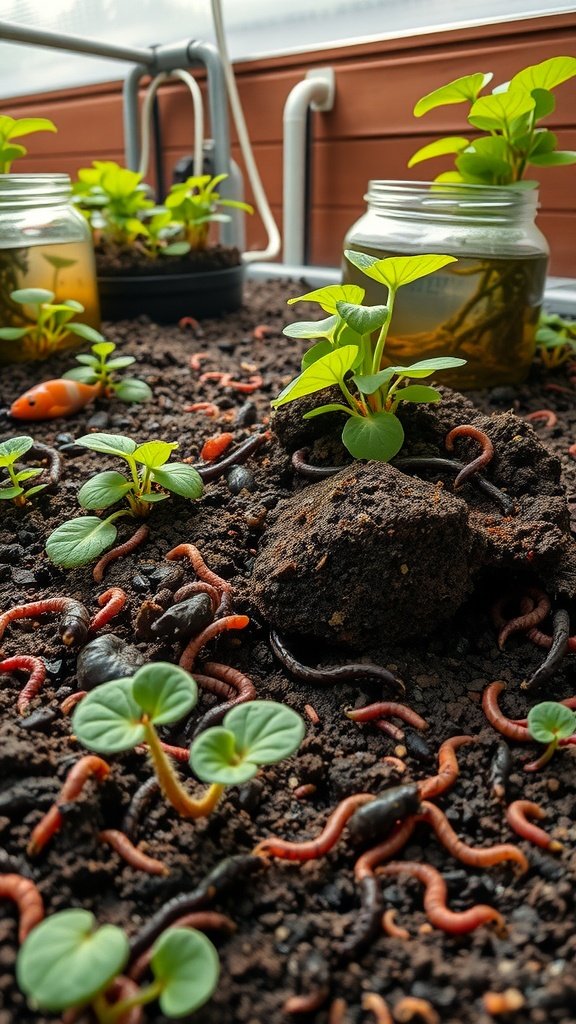
Imagine a vibrant garden where plants thrive and soil is alive with activity. This is what a worm composting system can bring to your aquaponic setup. The image shows a rich and earthy environment, filled with tiny red worms weaving through the soil, surrounded by young, green plants eager for nutrients.
Worms, particularly red wigglers, are fantastic for breaking down organic matter. They create a nutrient-rich compost that enhances plant growth. The worms feed on kitchen scraps, turning waste into valuable fertilizer. This not only keeps your garden eco-friendly but also ensures your plants receive balanced nutrition.
In the image, we see small jars and pots with clear water, hinting at a healthy aquaponic environment. The plants here are likely benefiting from both the worm compost and the nutrient-rich water from fish waste. It’s a beautiful synergy that promotes sustainable gardening.
To set up your worm composting system, start by creating a bedding of shredded paper or dry leaves. Add your worms and kitchen scraps, then keep the bedding moist. Check on them regularly, and soon you’ll see them working hard, turning waste into black gold for your plants. Your garden will not just grow; it will flourish in ways you might not have imagined!
Grow Herbs Like Basil, Mint, And Oregano In Aquaponics For Added Flavor.
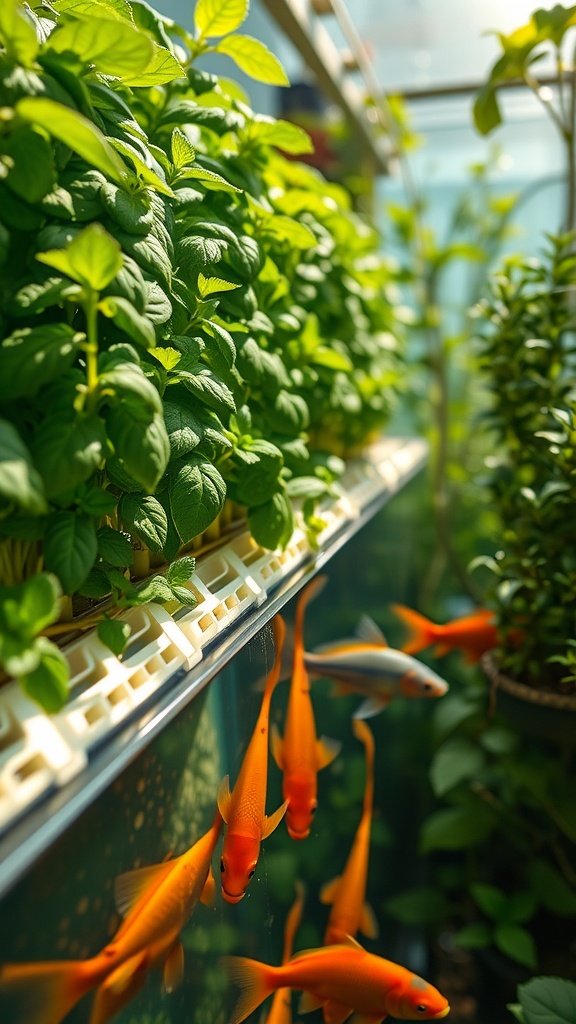
Aquaponics offers a unique way to grow fresh herbs right at home. Imagine a space filled with vibrant green basil, mint, and oregano thriving alongside lively fish. This image captures that perfect harmony. The lush green leaves are a feast for the eyes, while the orange fish gracefully swim below, creating a lively ecosystem.
Herbs like basil, mint, and oregano are perfect for aquaponics. They don’t just enhance your meals; they also thrive in this setup. The fish waste provides essential nutrients for the plants, while the plants help purify the water, leading to a win-win situation. It’s fresh, tasty, and sustainable.
Growing these herbs is simple. Start by selecting a small aquaponics system or build your own. Place the herbs in net pots above the fish tank. Ensure they get enough sunlight and monitor the water quality. With a little care, you’ll have plenty of fresh herbs to spice up your dishes.
Harvesting is easy too. Just snip what you need, and your plants will keep growing back. Imagine adding fresh basil to your pasta or mint to your drinks. It’s a great way to elevate your cooking!
Integrate Ornamental Fish Like Koi For Decorative Purposes.

Adding ornamental fish like koi to your aquaponic garden can create a stunning focal point. In the image, vibrant koi swim gracefully in a serene pond surrounded by lush greenery. This setup not only enhances the beauty of the garden but also contributes to a balanced ecosystem.
Koi are known for their striking colors and patterns, making them an attractive addition to any space. They can bring a sense of tranquility to your garden, providing a peaceful atmosphere for relaxation and enjoyment.
Integrating koi into your aquaponic system can also be beneficial. They help keep the water clean by eating algae and detritus, ensuring a healthy environment for both plants and fish. This synergy between fish and plants is a key principle of aquaponics.
When designing your aquaponic garden, think about the layout and integration of the pond. Create a visually appealing arrangement with various plants and stones. The colors of the koi combined with green foliage can create a vibrant, inviting space.
Experiment With Aquaponics To Grow Strawberries And Tomatoes Together.
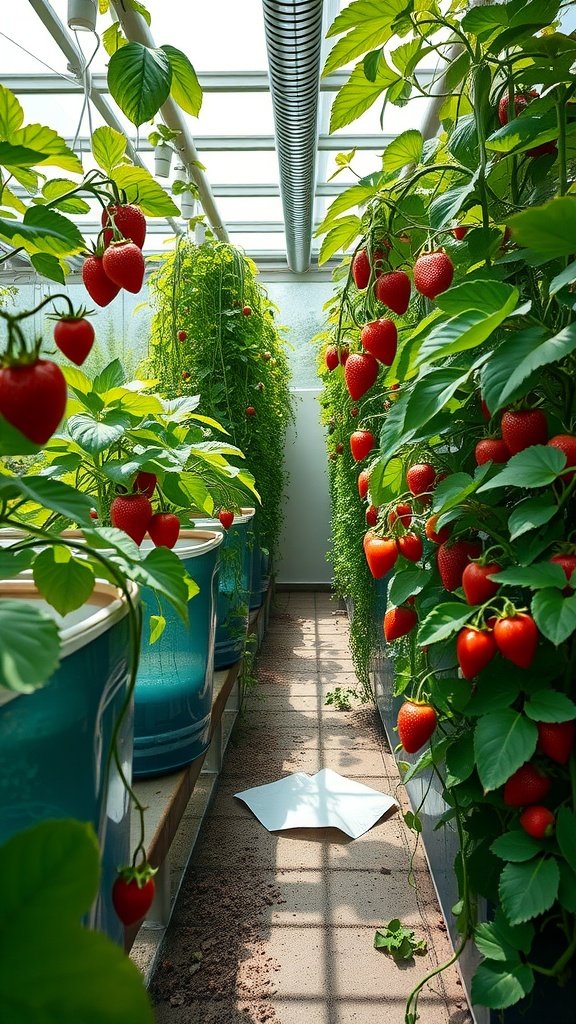
Imagine stepping into a vibrant space filled with lush greenery and the sweet scent of ripe strawberries. This image captures a well-designed aquaponics system where strawberries and tomatoes thrive side by side. Each plant receives the nutrients it needs from the water enriched by fish waste, creating a harmonious environment.
The bright red strawberries hang in clusters, enticing anyone who walks through. Their glossy skin reflects the sunlight filtering in, making the space feel alive. The blue containers hold the plants securely while the green leaves provide a refreshing backdrop.
Combining strawberries and tomatoes is a fun way to maximize your garden’s potential. The plants share space efficiently, and the benefits of aquaponics mean they grow stronger together. Not only do you get to enjoy fresh fruits, but you also engage in a gardening method that saves water and promotes sustainability.
Create A Deep Water Culture (Dwc) System For Maximum Plant Growth.
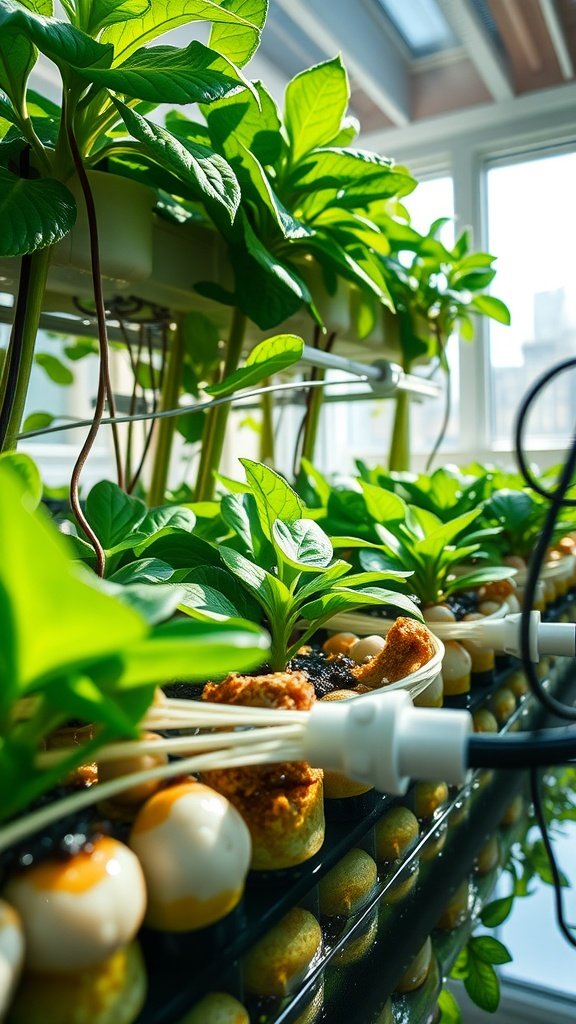
Deep Water Culture (DWC) is a fantastic way to grow plants in an aquaponic system. This method keeps plant roots submerged in nutrient-rich water, allowing for rapid growth and high yields. In the image, you can see vibrant green leaves thriving in a well-structured DWC setup, showcasing the system’s efficiency.
The setup includes net pots filled with a growing medium, where the plants are anchored. The roots extend into the water, getting plenty of oxygen through air stones. This ensures they receive the nutrients they need while staying hydrated. The bright sunlight filtering through the windows highlights the lush greenery, making this garden look lively and inviting.
Setting up a DWC system isn’t complicated. You’ll need a water reservoir, an air pump, air stones, and a nutrient solution. Simply fill the reservoir with water, add the nutrient solution, and connect the air pump to keep the water aerated. Position your plants in the net pots, and watch them flourish!
Use Aquaponic Gardening To Teach Kids About Sustainability And Ecosystems.
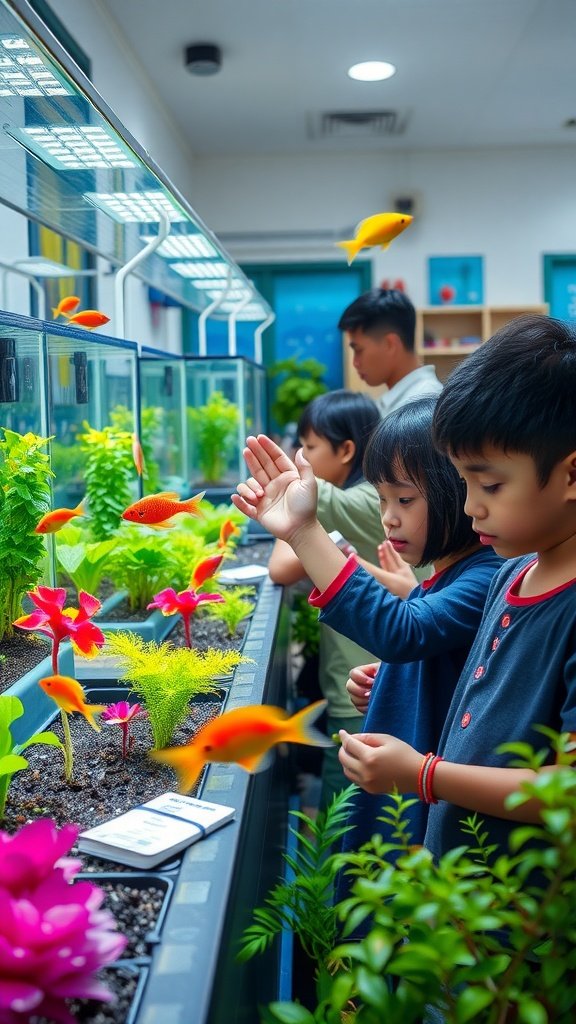
Aquaponic gardening is a fantastic way to engage kids in learning about sustainability and ecosystems. The image shows children observing colorful fish and vibrant plants in an aquaponics setup. This hands-on experience can spark their curiosity and encourage them to explore how different elements in nature interact with each other.
When kids see fish swimming above plants, they can connect the dots between aquaculture and agriculture. Fish waste provides nutrients for the plants, and in return, the plants help purify the water for the fish. This cycle mimics natural ecosystems, making it an exciting educational opportunity.
Involving children in aquaponic gardening helps them understand the importance of water conservation and the role of healthy food systems. They can learn about the responsibility of caring for living organisms and how their actions affect the environment. Watching their plants grow and fish thrive can instill a sense of achievement and responsibility.
These garden setups can be small enough to fit in homes or classrooms, making them accessible for everyone. Plus, kids love to get involved in hands-on projects, and nurturing plants and fish offers a unique way to learn about life cycles, biodiversity, and sustainability.
